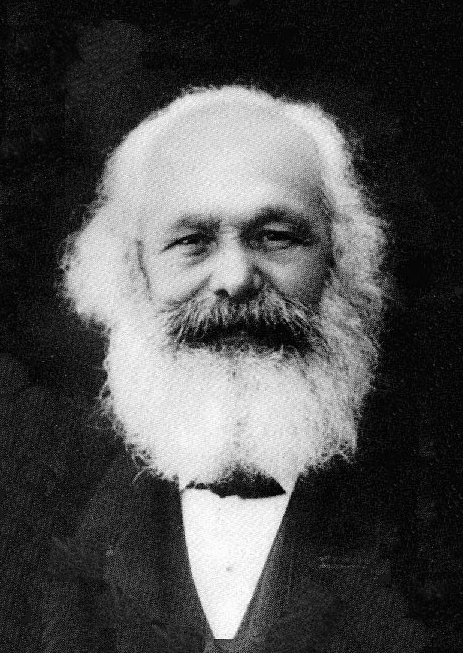The history of modern political economy traces back to the works of Adam Smith and Dave Ricardo, who writing in the 18th and 19th Century outlined a model which was broadly supportive of the developments of economic markets and free trade, and was based upon a labour theory of value, which suggested that the value of the goods and commodities produced is directly related to the amount of labour which goes into making that product. Smith and Ricardo’s work was taken up in the mid 19th century by Karl Marx who in 1867 published Capital: Critique of Political Economy, which functioned as a critique of the emergent political economy of capitalism during the industrial revolution. Marx’s major contentions are worth exploring here, as his work remains a foundation for studies of PE, and the basic concepts and categories he proposed are still commonly employed within media studies today, almost 150 years after he devised them.

CC Image from Wikimedia Commons, Author Unknown
Marx begins Capital by identifying the commodity – a material entity which can be bought or sold – as the basic unit on which capitalist economies are built, and then proceeds to distinguish between the use-value and exchange value of a commodity. Whereas use-value relates to the value inherent in the way that a good is used, be it to feed someone, provide primary resources for manufacturing or provide information or entertainment to someone, exchange value refers to the fluctuating value which is attached to those goods. Indeed, during the time of the industrial revolution when Marx was writing, the spatial distribution of goods and markets meant that financial speculators were able to amass vast sums (by the standards of the period) by purchasing goods in one location and moving them to another location before selling them at greatly increased prices. Whilst the use-value of these goods remained constant – they would be used in the same way in both areas – their exchange-value varied considerably, allowing a particular privileged class of people (those with the financial resources to buy large quantities of goods and transport them to another city) to exploit the productive labour of others (those who actually produced the goods in the first place) in order to further entrench their wealth. This is a crucial point, as it reveals that Marx’s approach to political economy reveals ways that capitalism is dependent upon a system whereby the productive labour of one social group is exploited by another, wealthier class who effectively own the means of production and can further entrench their elite financial status through financial speculation which the working class who create the commodities themselves cannot participate in. Pivotal to Marx’s work then, were the social relations between different classes within the emergent capitalist society of which he was a part, and the ways in which privileged classes, which he terms the bourgeoisie, exploit the labour of the working classes, whom Marx calls the proletariat.
Marx builds upon the notion of a labour-theory of value, contending that all exchange value is effectively derived from the amount of time someone had to spend working to create a commodity. This quantifiable temporal unit, however, is itself approached as something which is dynamic and changes depending on social development and structuring. Marx uses examples drawn from the changes to the textile industry within the industrial revolution, in which the introduction of a range of new technologies such as the power-loom – which effectively halved the time that was required to weave a given length of yarn into cloth – transformed the socially accepted amount of time required to produce commodities. Whilst there were still artisans hand weaving after the invention of the power-loom, they only received half the wage they had done previously.
Another important distinction which Marx makes with respect to value, is the introduction of the concept of surplus-value. Whereas the use-value of a commodity relates to the work of the labourer in producing it, under capitalism, Marx posits that the exchange value cannot merely be a direct representation of use-value, as in addition to the work of producing the commodity itself, capitalists (factory owners and merchants) are required to add value to the commodity in order to extract profits from its sale and subsequent circulation within markets. These added costs to the exchange value of commodities are what Marx terms surplus value. This again is used by Marx to suggest that capitalism is an inherently exploitative socio-economic system, as this means that it is predicated upon the capitalist classes from extracting value which is removed from the use-value of goods, and this is what allows them to make a profit.
Furthermore, in a social situation in which advances in science and technology frequently involve the insertion of machines which can reduce the amount of labour required to produce commodities – a process which is still very much relevant to a contemporary situation where digital technologies such as non-linear editing software, digital cameras and cloud-based server systems can allow the production of media with dwindling amounts of labour time – the tendency over time is for the tendency of the rate of profit to fall. This basically states that because technology advances over time, equal quantities of commodities can be produced in diminishing temporal durations, which entails that their exchange value will depreciate if all else is equal. Consequently, Marx argues that in order to maintain and grow profits, capitalists have to enact more and more repressive conditions within the workplace to counteract the tendency of the rate of profit to fall.
Philosophically, Marx inverts G.W. Hegel’s idealist perspective, contending that:
‘The mode of production of material life conditions the general process of social, political and intellectual life. It is not the consciousness of men that determines their existence, but their social existence that determines their consciousness’ Marx, 1859 p4



